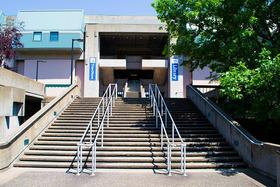- The mission of the College is to offer highly focused, high-quality, condensed career-oriented programs for the purpose of enabling each student to successfully complete his/her program of study.
School Highlights
Sanford-Brown College-Fenton served 15 students (87% of students were full-time).
The college's student-teacher ratio of 5:1 was lower than the state community college average of 16:1.
Minority enrollment was 73% of the student body (majority Black), which was more than the state average of 41%.
School Overview
Sanford-Brown College-Fenton
(MO) Community College Avg.
Carnegie Classification
Associates Colleges
Baccalaureate Colleges: Diverse Fields
Institution Level
Four or more years
At least 2 but less than 4 years
Institution Control
Private, for profit
Public
Year Founded
2000
Total Faculty
3 staff
139 staff
Student Body
Total Enrollment
15 students
2,125 students
Student-Teacher Ratio
5:1
16:1
# Full-Time Students
13 students
718 students
# Part-Time Students
2 students
1,407 students
# Enrollment Undergraduate
192 students
246 students
# Full-Time Undergraduate Students
13 students
834 students
# Full-Time Graduate Students
n/a
11 students
# Part-Time Undergraduate Students
2 students
684 students
# Part-Time Graduate Students
n/a
9 students
Total Dormitory Capacity
n/a
200 students
% American Indian/Alaskan
1%
n/a
% Asian
n/a
2%
% Hispanic
2%
6%
% Black
8%
10%
% White
27%
59%
% Hawaiian
n/a
1%
% Two or more races
1%
4%
% Non Resident races
n/a
1%
% Unknown races
61%
17%
Diversity Score
0.55
0.61
College Completion Rate (Students who graduate in less than 4 years)
n/a
43%
College Completion Rate (Students who graduate in 4 years or more than 4 years)
n/a
62%
Average Graduate Earnings (10 Years)
$29,600
$30,900
Tuition and Acceptance Rate
% Students Receiving Some Financial Aid
95%
94%
Median Debt for Graduates
$19,785
$10,450
Median Debt for Dropouts
$6,625
$5,500
Acceptance Rate
n/a
94%
Source: 2015 (or latest year available) Integrated Postsecondary Education Data System (IPEDS)
School Notes
- Founded in 1866, Sanford-Brown College in Fenton, Missouri is a private, career-oriented college offering focused, quality bachelor's, specialized associate, diploma and certificate programs in the information technology, business and healthcare fields. At Sanford-Brown, you can customize your skills rapidly and successfully to the specific needs of a future work setting. Unlike traditional institutions, we enable adults to complete their programs of study in as little as nine months. Generally, classes start every five weeks, so you can get started quickly with convenient day and evening classes to meet your needs. At Sanford-Brown, your studies focus primarily on the essential concepts and skills most employers look for in entry-level employees. Our goal is to provide you with the practical information and experience you need to get your foot in the door. We avoid requiring you to take courses that are not directly supportive of your employment objective. Technology plays a major role in all the professions for which we train our students. That's why we use industry current tools to help deliver your education more effectively. During the hands-on component you will use industry-oriented equipment to gain experience applying your knowledge.
Recent Articles

Student Success Programs That Actually Work at Community Colleges
Discover evidence-based student success programs at community colleges for 2025, with outcomes, examples, and actionable strategies.

Best Community Colleges by Career Path in 2025
Explore top community colleges for career-training programs in 2025, including healthcare, IT, skilled trades and business pathways.

Dual Enrollment in High School: Benefits, Risks & Real Student Results
Explore the pros and cons of dual enrollment in high school, real outcomes for students in 2025, and how to decide if it’s right for you.





